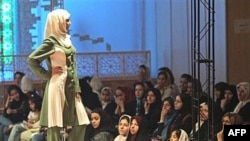Iran has unveiled a number of "Islamic" products including an Islamic tie.
The tie, which is shaped like the sword of Imam Ali (cousin and son-in-law of the Prophet Muhammad who is considered by Shi'a as his rightful successor) and decorated with an Islamic hadith (a saying attributed to Muhammad), has been registered in the Islamic republic by inventor Hemat Komeili. (For a picture, click here.)
Komeili has been quoted as saying that his tie has been approved by some of the sources of emulation. He says it appears beautiful like a tie in addition to being based on Islamic values.
Ties came under attack in Iran following the 1979 revolution as one of the symbols of "decadent" Western cultures. It was reported that men with ties were detained in the early days of the revolution and according to unconfirmed reports in some cases their ties were cut off.
Some Iranian men still wear ties in public even though it is generally condemned and disapproved by the country's leaders and clerics.
Meanwhile an Iranian company says it has created the first Islamic doll.
Iran had in the past created two dolls, "Sara" and "Dara," which were to counter Barbie and Ken but reportedly were not very popular. The new doll, which is branded Islamic and not Iranian, has the Arabic name "Fatima."
Hossein Homay Seresht, of the company Fam that created Fatima, says the doll is meant to fight the "enemies' cultural invasion" of the Islamic republic.
Seresht says that Iran's enemies are increasingly targeting 3-year-old kids.
"The Westerners, by creating Barbie and marketing it, are encouraging bad veiling and not wearing the hijab; all of these factors led us to take it as our duty to present Islamic dolls to the market," he said.
The company has also produced the "Hijab Forbidden" software, which despite its name is designed to promote the Islamic hijab, or veiling.
Seresht says the software includes video clips of Islamic fashion, speeches about the hijab and a "Hijab Messenger," an instant messaging service that he said is based on the same model as Yahoo messenger but that chat can only take place with "people who are defined within the system."
He provides no further details and does not say whether it means that only people who are wearing the hijab or those who support the hijab can use it.
-- Golnaz Esfandiari
The tie, which is shaped like the sword of Imam Ali (cousin and son-in-law of the Prophet Muhammad who is considered by Shi'a as his rightful successor) and decorated with an Islamic hadith (a saying attributed to Muhammad), has been registered in the Islamic republic by inventor Hemat Komeili. (For a picture, click here.)
Komeili has been quoted as saying that his tie has been approved by some of the sources of emulation. He says it appears beautiful like a tie in addition to being based on Islamic values.
Ties came under attack in Iran following the 1979 revolution as one of the symbols of "decadent" Western cultures. It was reported that men with ties were detained in the early days of the revolution and according to unconfirmed reports in some cases their ties were cut off.
Some Iranian men still wear ties in public even though it is generally condemned and disapproved by the country's leaders and clerics.
Meanwhile an Iranian company says it has created the first Islamic doll.
Iran had in the past created two dolls, "Sara" and "Dara," which were to counter Barbie and Ken but reportedly were not very popular. The new doll, which is branded Islamic and not Iranian, has the Arabic name "Fatima."
Hossein Homay Seresht, of the company Fam that created Fatima, says the doll is meant to fight the "enemies' cultural invasion" of the Islamic republic.
Seresht says that Iran's enemies are increasingly targeting 3-year-old kids.
"The Westerners, by creating Barbie and marketing it, are encouraging bad veiling and not wearing the hijab; all of these factors led us to take it as our duty to present Islamic dolls to the market," he said.
The company has also produced the "Hijab Forbidden" software, which despite its name is designed to promote the Islamic hijab, or veiling.
Seresht says the software includes video clips of Islamic fashion, speeches about the hijab and a "Hijab Messenger," an instant messaging service that he said is based on the same model as Yahoo messenger but that chat can only take place with "people who are defined within the system."
He provides no further details and does not say whether it means that only people who are wearing the hijab or those who support the hijab can use it.
-- Golnaz Esfandiari





